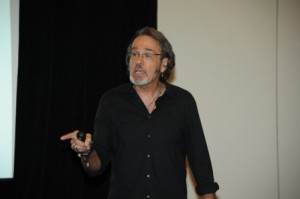By Lila Ivey

“Nonsense!” says author Doug Williams, and he’s got the statistics to prove it.
Doug’s premise: It’s better to be effective than to be good. Follow a few rules and you can be effective. One of his keystones is “Cognitive Ease vs. Cognitive Strain” from the book Thinking Fast and Slow. When the brain is at ease, it smiles. The key is to be concise, clear and simple upon a single read.
The Research: In 1980, the average attention span was 22 seconds. Then came MTV, so by 2000 the attention span dropped to 12 seconds; in 2013 it was 8 seconds; and in 2014, it’s just 2.8 seconds. The Internet has contributed even more to our ADD with page views lasting less than 4 seconds. On YouTube you’ve lost your audience in 10 seconds.
KISS – More facts substantiate that rule: 75 percent of all words are one syllable, so use them. The brain will smile more if you use single-syllable words.
How about sentences? Readers assimilate in 18-word blocks, so average 15-17 words. Use the Breath Test. Read your sentences aloud. If you have to take a breath, insert a period. You will get 100 percent comprehension with even shorter sentences, such as eight words. Your goal is to write at the 6th to 7th grade level; 4th grade is even better, but that doesn’t mean you are writing for a fourth grader. It means you’re using words brilliantly to achieve the highest level of understanding.
Paragraphs? 1-4 lines; 1-2 sentences; 17-40 words. No such thing as a minimum length. Online? Just 40-55 characters per line. Big blocks of gray will never be read. White space and good line spacing will guide the eye and make the brain smile ever wider.
People don’t ready, they scan. The eye starts in the upper left and scans down to the lower right, so write for the eye with:
- White space
- Short text bocks
- Bullet points (three is good, max out at 5; never 7)
- Boldface value statement
- Quote-outs
- Subheads
- Ragged right copy
Writing well is like writing in headlines. Study The New York Times. Every line is a headline.
Reading web pages. Studies show that the eye/brain reads the first paragraph, then the left side of the second paragraph, and then it “bulletizes” text and slides into the inverted pyramid of scanning. An infrared image of the brain reading a web page forms an F-shape.
Write like you speak. Be conversational.
- Use contractions
- Personalize
- Loosen sentence structure
- Read it aloud
- Be audience appropriate
The best way to edit is to read your copy aloud. All the errors will show up. Doug also says it’s just fine to start sentences with “And” or “But.” He swears it’s okay…because that’s the way we speak. Doug says we need to forget about the Latin rules of not splitting infinitives and revering formalities created by 17th century British bishops.
The “elevator message” is dead. We have to speed it up:
- One-word equity – find the one word that captures the essence of your message.
- Rhymes e.g., Woes unite foes; life is mostly strife, if it doesn’t fit, you must acquit (this is called process fluency and the brain not only understands it, it also believes it)
- Start with a question – engages the reader and makes them think
- Frame the Message – once upon a time, every day, one day, because of that (repeat two or more times); until finally (this is the PIXAR six-part sequence) – leading to the conclusion.
Seven writing mistakes:
- Masked verbs – reach a decision; come to a conclusion, verbs are the pivotal part of a sentence so use strong ones
- Problem structure – This is and There are – very weak ways to begin a sentence
- Intruders – situation, conditions, schedule
- Useless distinctions – avoid using vague words
- Writer-centered words – use simple, not 50-cent words
- Adverbs are not your friends…avoid words that end in – ly
- Prepositional phrases – delete!
 ABOUT DOUG WILLIAMS
ABOUT DOUG WILLIAMS
Doug Williams is president of Fuse 5, a Houston-based marketing, public relations, writing, training and special events firm. His background includes writing in a comprehensive range of media in multiple industry sectors, and he is a frequent speaker and leads communication related training seminars throughout North America. He’s also a novelist, playwright, filmmaker and award-winning screenwriter. Williams is a former journalist, editor and columnist; worked as a press secretary in the U.S. Senate; and served as chief creative writer and senior vice president for public relations and public affairs at a large regional advertising agency. Additionally, he has managed corporate communications, branding and marketing functions in both the public and private sectors, representing for-profit and not-for-profit entities.

